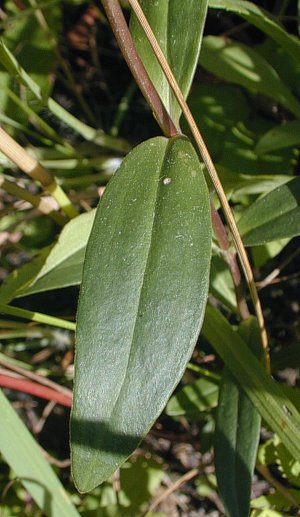Description: This perennial plant is ½–2' tall, and is unbranched. The light green or reddish central stem is slender and smooth. The opposite leaves are narrowly ovate to elliptic and sessile. They have smooth margins, a prominent central vein, and are hairless. The leaves are up to 3½" long and 1½" across; their upper surfaces are medium to dark green and shiny.

In the upper part
of the plant, 1-6 flowers develop from axils of the opposite leaves,
with a greater number of flowers at the apex. These tubular flowers are
pale blue to blue-violet, often with vertical streaks of purple, green,
or white. They are about 1½" long and closed at the top (or nearly so).
Each flower has five lobes, with each adjacent pair of lobes connected
together by a lighter colored membrane. This membrane is the same
length or slightly lower than the adjacent lobes, with an irregular
pattern at the top; it is not readily perceptible unless the lobes of
the flower are spread apart. Underneath the flowers, the lanceolate
lobes of the calyx are erect, spreading only slightly outward; they are
not recurved. The blooming period is late summer to fall, and lasts
about a month. There is no noticeable fragrance to the flowers. The
seed capsules split into 2 sections, releasing numerous small seeds
that can be dispersed by wind or water. The root system consists of a
long stout taproot.
 Cultivation:
The preference is full or partial sun, and moist to mesic soil. This
gentian often grows in sandy soil, but will tolerate
other kinds of soil, including fertile loam. Foliar disease is not a
significant problem, although the leaves sometimes turn yellow in
response to strong sunlight and dry weather. It is faster and easier to
introduce gentians as transplants, rather them to start them by seed,
which is difficult and slow.
Cultivation:
The preference is full or partial sun, and moist to mesic soil. This
gentian often grows in sandy soil, but will tolerate
other kinds of soil, including fertile loam. Foliar disease is not a
significant problem, although the leaves sometimes turn yellow in
response to strong sunlight and dry weather. It is faster and easier to
introduce gentians as transplants, rather them to start them by seed,
which is difficult and slow.
Range & Habitat:
The native Soapwort Gentian is an uncommon plant that occurs in NE
Illinois and a few counties in southern Illinois (see Distribution
Map). It can occur in other localities as a result of
restoration activities, or as an escape from cultivation. Habitats
include moist to mesic sandy Black Oak forests, sandy savannas, sand
prairies, and sandy thickets. Less often, this gentian can be
found in non-sandy habitats that are similar to those already
mentioned. This conservative plant is rarely found in disturbed areas.
Faunal Associations:
Bumblebees are the primary pollinators; they are strong enough to force
their way into the flowers, where they suck nectar. Sometimes tiny
beetles sneak into the flowers to feed on the pollen, while some larger
beetles, such as Epicauta pensylvanica (Black
Blister Beetle), may knaw on the flowers themselves. The seeds are too
small to be of any interest to birds, while the bitter foliage is too
bitter deters most herbivores; however, deer sometimes chomp off the
tops of the plants.
Photographic Location:
The photographs were taken at Hooper Branch Savanna Nature Preserve in
Iroquois County, Illinois. This plant was growing in a moist sand
prairie.
Comments:
Soapwort Gentian usually has pale to medium blue flowers, while Gentiana
andrewsii (Bottle Gentian) often has deep blue flowers. Color
alone, however, is not a reliable guide to species identification. The
calyx lobes in flowers of Soapwort Gentian are fairly straight and
upright, while the calyx lobes of Bottle Gentian often curl outward. In
the flowers of Soapwort Gentian, the connecting membranes are a little
lower than, or equal to, the lobes of the corolla, while they are
higher than the lobes in the flowers of Bottle Gentian. There is also a
tendency for Soapwort Gentian to have more slender leaves and stems
than Bottle Gentian, but this distinction is not always reliable.
Soapwort Gentian differs from Gentiana alba (Cream
Gentian) with its bluer, less open flowers and sessile leaves, whereas
the leaves of the latter strongly clasp the stem.